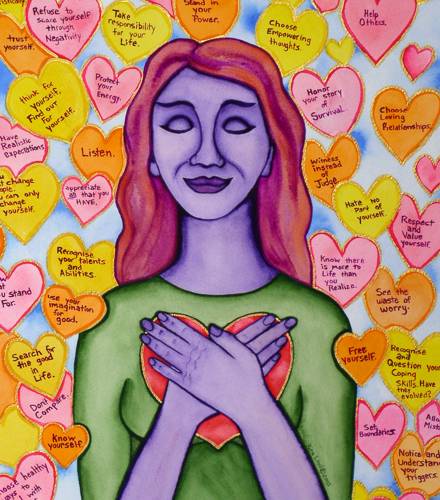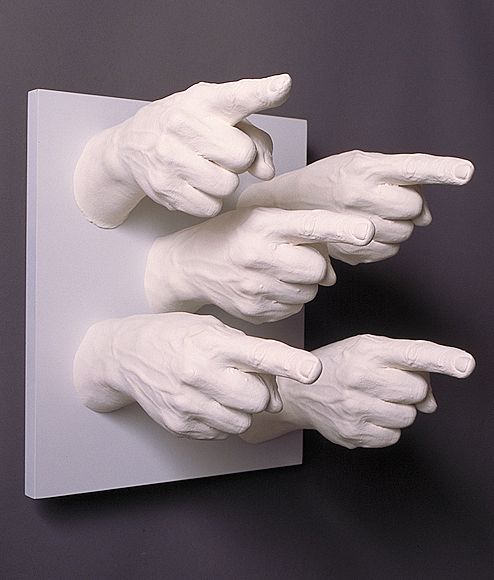Question
Catherine asked us this question: “How can I continue to strive to regard myself as worthy of [tag-tec]unconditional love[/tag-tec] in a relationship, just as I am?”
She asked this because, in her words, “I have been in two long-term relationships that ended with me feeling used and taken for granted. I came out of them thinking that I must be doing something that gives the impression I am not worth making an effort for — that I am perceived as the one who meets needs without requiring any reciprocal effort to meet mine as well”
There are many ways we could answer this question, but we would like to address how Catherine (or anyone for that matter) can start treating herself like she’s [tag-tec]worthy of unconditional love[/tag-tec].

Artwork by Rita Loyd
Which might cause you to ask, “Easy to say, but how can I do that”?
You can start with these three beginner’s steps to practicing [tag-tec]self-love[/tag-tec]. By applying these self-love techniques you will automatically start treating yourself as the valuable being that you inherently are.
What are You Thinking About?
Step One: Explore your thinking.
Whether you’re aware of it or not, it’s the thoughts you think that generate the way you feel about yourself. The way you feel about yourself influences the actions you take. And your actions generate everything you create in your life.
Most of us have been raised in cultures that teach us to focus on what’s happening outside of ourselves as being responsible for creating the situations in our lives. “If only they wouldn’t…” “If only it hadn’t…” “If only you would…” “It wasn’t me. It’s two other guys…”
When you primarily focus on what’s going on “out there” it’s very challenging to really know what’s going on “in here”–to know yourself, and to understand what’s most important to you.
So, if something happens “out there” that you don’t enjoy, and all you know to do is try and change those external circumstance, you’re bound to feel bad. Why? Because without first changing your internal reactions it is much harder to effectively change your external circumstances. Or, as Einstein put it:
“Problems cannot be solved by the same level of thinking that created them.”
That is why we suggest you start the practice of exploring your internal thoughts as the first step to treating yourself as worthy of unconditional love. You will know which thoughts are important to explore by using your feelings as an alarm.
The next time you feel uncomfortable in any way, try to identify what you were thinking about just before you started feeling uncomfortable. Then use the next step to change this level of thinking.
Identify Your [tag-tec]Personal Core Values[/tag-tec]–Who You are at a Deep Level
Step Two: Identify what’s most important to you.
The quickest way to start giving yourself unconditional love is to get to know yourself well enough that you can appreciate who you are–even when you don’t like how you feel.
Shakespeare said it best when he wrote, “To thine own self be true.”
Discovering what’s most important to you–what you most deeply value–is the best way we know to discover who you truly are.
These [tag-tec]personal values[/tag-tec] are sometimes well hidden inside your every day feelings. The stronger your feelings–the more important the value is that they express.
In step one you identified what you were thinking about just before you started feeling uncomfortable. Now that you’ve interrupted the thought, ask yourself questions such as: “What is so important to me in this situation that I feel so strongly about?” “What is missing for me that is so important?”
For example, underneath a sense of deep sadness, you might discover caring and consideration are very important to you, and those things are missing in the situation at hand. Hidden within confusion could be a strong desire for understanding. Beneath frustration, you could discover that you want to be more effective.
When you can get under your feelings to what’s deeply important to you—you will start to notice wonderful qualities about yourself. So rather then being stuck in the negative thoughts and the feelings they generate, you can discover “thine own self”–a valuable person you can easily learn to love.
Knowing YOU is Loving YOU
Step Three: Get to know your best friend.
Although at times you may feel very sad, frustrated or lonely, once you learn to stop yourself the very moment you begin feeling uncomfortable, and then identify what’s most important to you beneath your feelings, you’ll find that you can always be there for YOU. You can listen to what’s important to you. You can figure out ways to get more of whatever you deeply value that is missing in your life.
Using these self-love techniques you are guaranteed to find the best friend you’ve ever had and will be well on your way to mastering the art of self-love and acceptance.
Never Settle for Less Again
Now we’d like to get back to the other thing Catherine said: “I have been in two long-term relationships that ended with me feeling used and taken for granted. I came out of them thinking that I must do something that gives the impression I am not worth making an effort for – that I am perceived as the one who meets needs without requiring any reciprocal effort to meet mine as well.”
[tag-tec]Loving and accepting yourself[/tag-tec] is the first step to creating unconditional love in all your relationships. This will make it much easier to experience the mutual respect and consideration you desire. With practice at interrupting negative thoughts, and then discovering what you really want, you’ll gain the confidence to ask for what you want and know that you’re worth getting it.




 Do you ever find yourself unsure of what you “need” in a situation or what would be the “best” thing to do? Would you like more confidence that the decisions you make are not sowing the seeds of regret? If so, you may be intrigued by our response to this question from our community: “What’s the difference between [tag-tec]values and needs[/tag-tec]?” This is our attempt at a very brief education about [tag-tec]core human values[/tag-tec] and a look at how to develop what we call your [tag-tec]Values Intelligence[/tag-tec], or V-IQ.
Do you ever find yourself unsure of what you “need” in a situation or what would be the “best” thing to do? Would you like more confidence that the decisions you make are not sowing the seeds of regret? If so, you may be intrigued by our response to this question from our community: “What’s the difference between [tag-tec]values and needs[/tag-tec]?” This is our attempt at a very brief education about [tag-tec]core human values[/tag-tec] and a look at how to develop what we call your [tag-tec]Values Intelligence[/tag-tec], or V-IQ.





